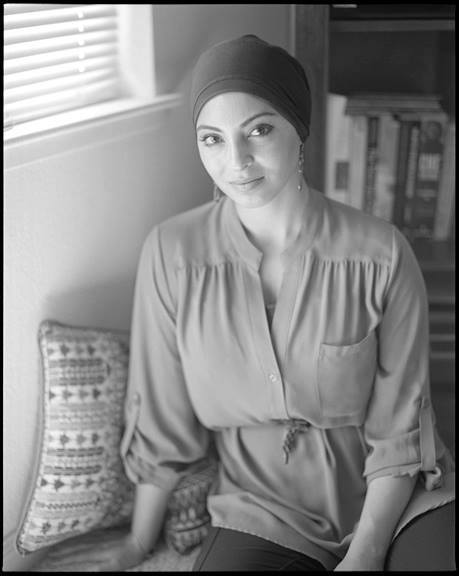Multi-media exhibit documents Bay Area Palestinian community
The San Francisco Public Library will host “Home Away from Home: Little Palestine by the Bay” an exhibit by Palestinian photographer Najib Joe Hakim.
“Home” combines photography and recorded oral histories to tackle the question, “What does it mean to be Palestinian in America?”
The exhibit opens August 28 with an opening reception at the Library’s Koret Auditorium that afternoon. Attendees will have the opportunity to meet Hakim and listen to him speak about the exhibit.
“Home” consists of 27 Black and White portraits of members of the San Francisco Palestinian community—the second largest Palestinian community in the U.S. according to the exhibit description. Each photograph is accompanied by a voice recording of the subject telling his or her story.
Hakim said he decided to juxtapose the recorded oral histories with the portraits in order to form a greater emotional impact on the viewers.
“It’s one thing to look at the picture and read a caption, but when you actually hear the voice of somebody talking to you, telling you about their experience, their feeling or something, I think the ability to emphasize, the connection is so much more powerful,” he said.
Leena Barakat, whose photo and recorded interview is part of the exhibit agrees that the two elements help to humanize the people profiled in the exhibit.
“Photos alone or just the oral alone, it doesn’t tell the whole story. I think being able to, you know, people are very visual, they need to see and just looking at the lines on people’s faces, looking at the expressions on their faces they really sort of connect more with that person,” Barakat said.
The subjects of the exhibit are diverse in terms of gender, age, and religion and consist of a mix of people who were born in Palestine or in the United States. Hakim said that he was struck by the fact that everyone he interviewed, regardless of where they were born, called Palestine “back home.”
“To feel it in such an intimate way, to call it back home, even if they’ve never seen it, you know, I thought it kind of suggested the longevity, and the permanence or the transferability of the connection of the place through the generations or through time,” he said.
“Home” was inspired by what Hakim saw as an absence of opportunities for Palestinians in America to speak for themselves.
“I grew up in this country, and over the years I noticed whenever people talked about the Palestinians in the media it was always someone else speaking about us or for us or something and it was, I felt that we need to speak for ourselves and we needed an opportunity and platform to speak for ourselves,” Hakim said.
Hakim noticed Palestinians are constantly required to prove their credibility in the U.S. That is why he says that the project has an “ethos of maintaining as much credibility as possible.” The photographs were shot on film, so they can be authenticated on the unchangeable negatives, and only natural lighting was used “to add to that sense of being genuine.”
Barakat explained that being a part of the project gave her the opportunity to show people what the stories of Palestinians in the U.S. look like.
“For me it was being able to tell my story and the story of so many others—I know my story is just one of many—and to push people to kind of see what these different stories look like as Palestinians living in the Bay Area or just members of the diaspora. So,showing the different colors of everybody’s stories, I think is very important,” Barakat said.
“Home” is the second installation of Hakim’s proposed trilogy. The first piece “Born Among Mirrors: Fifty Years After,” has to do with Hakim’s family’s journey from Palestine to Lebanon, and then to the United states.
“Born Among Mirrors” displays photographs taken by Hakim’s father on the day his family left Lebanon for the United States. These images are juxtaposed by photos taken by Hakim 50 years later when he went to Lebanon to document the damage caused by the 2006 war.
A video about “Born Among Mirrors” will be displayed in the “Home” exhibit along with a video that includes snippets of the interviews for “Home.” Hakim is unsure about what the final installation of his trilogy will entail, but he does hope to eventually combine the three parts in some way.
“I would like to actually put this all together in something tangible like, you know, a book or whatever. That’s kind of old school, but I’m kind of old school so I would really love to put together something that outlasts me and can actually be used in the future in a permanent way,” Hakim said.
Hakim hopes that his exhibits will help challenge stereotypes about Palestinian communities and to humanize Palestinians. He hopes that a shift in Americans’ perceptions about Palestine can eventually influence U.S. foreign policy.
“The ultimate goal of the project is to help contribute to positive change in U.S. foreign policy towards the Middle East and Palestine in particular because it’s really U.S. foreign policy that is the main problem going on there,” Hakim said. “Nothing, none of the stuff that Israel is doing would be possible without American support and backing, and if America can change, American policy can change, then we can really have a chance for real peace over there.”
This will be the fourth exhibition of “Home”—two previous exhibitions were held in the Bay Area and one in Washington D.C. Hakim hopes to display his project in more venues, especially in Detroit and Chicago which has one of the largest Palestinian population in the U.S.
The exhibition in the San Francisco Public Library runs through November 27. To view the exhibit hours, visit the library website. The portraits and recorded histories featured in “Home” can be viewed online.





